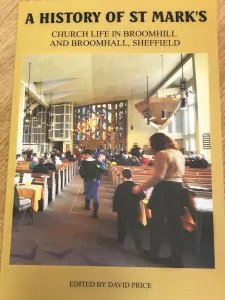History
St Mark’s Church, Broomhill, is distinctive both for its outstanding modern architecture and for its thoughtful, liberal approach to questions of faith.
It was founded in 1859 as an Iron Church to serve the expanding Sheffield suburb of Broomhill. In 1871, this was replaced by a fine stone neo-Gothic building designed by W H Crossland. St Mark’s became a large, active and well known church.
In December 1940, the Church was struck by an incendiary bomb. Only the tower and spire survived. For 23 years, services were held in the Church Hall. Eventually, the distinguished architect, George Pace, designed a new St Mark’s which was consecrated in September 1963. Since then, the church has progressed in many ways, including improvements to the building, strengthened links with the local community through the Broomhill Festival and the creation of the St Mark’s Centre for Radical Christianity in 2003. When St Silas, Broomhall, closed in 2000, much of Broomhall was added to St Mark’s parish.
Virtual Heritage Tour
A virtual tour of St Mark’s church with commentary from members of our church community which was filmed in August 2020 for the Heritage Open Days festival.
A History of St Mark’s

'A History of St Mark’s: Church Life in Broomhill and Broomhall, Sheffield,’ edited by David Price, was launched on 27 September 2013 to mark the 50th anniversary of the outstanding church building by the great church architect, George Pace. The book traces church life at St Mark’s from its Victorian beginnings – the original iron church, the stone church and its destruction by incendiary bombs in 1940, the ‘exploratory pioneering approach to Christianity’ developed in the 1960s, St Mark’s’ influential role in the movement for the ordination of women in the 1990s and more recently its conferences on ‘radical Christianity’ which attract people from far and wide.
It tells the story of a church with a national profile that follows ‘a this-worldly Jesus, with a message and way of life for here and now’.The book was written almost entirely by members of the present congregation and contains over 100 illustrations.
The Chapters of the book are:
1. ‘Origins – to the consecration of the stone church in 1871′ by Rosie Richards.
2. ‘The early years of the stone church 1871-1918′ by Helen Mathers.
3. ‘The inter-war years 1918-1940′ by Tim Moore.
4. ‘Destruction and survival 1940-1960′ by Tim Moore.
5. ‘The new St Mark’s 1960 – 9′ by David Price.
6. ‘The seventies and most of the eighties 1970 – 87′ by David Price.
7. ‘The nineties and the noughties 1988- 2008′ by David Price.
8. ‘A living thinking faith – St Mark’s today’ by Michael Hunt.
9. ‘How to read St Mark’s’ by Richard Taylor.
10. ‘Concluding reflections’ by Ian Wallis.
If you would like to order a copy, contact the church office – office@stmarkssheffield.co.uk
Our Logo

St Mark’s Logo, designed by the late David Stoker (1979-2010), is a distinctive emblem intended to communicate vitality and essence.
The overall shape is cruciform, locating the community within the Christian story. The intersecting lines resonate with the East and West windows, rooting that community within a particular building, namely St Mark’s.
Woven within the lattice are three strands of meaning. Overall, the structure expresses inclusivity, dynamism and synergy. The interleaving of the vertical and horizontal axes represents the convergence of the sacred and the secular. The enclosed cell provides a generative core giving rise to creativity, openness and exploration (open ‘quarters’).
The multi-coloured matrix expresses variety and reconciliation, with the graining and jagged edges conveying something of the subtlety and open-endedness of faith. The colours are also significant: grey encapsulates the earthiness of existence, a being-towards-death characterised by challenge, ambiguity and pathos; blue bears witness to the life force of nature; yellow celebrates the life force of grace.